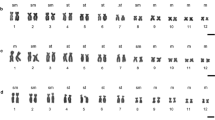Abstract
Karyotypes of three species of Bothriocephalus were studied using conventional Giemsa staining and comparative karyometric analysis. Bothriocephalus claviceps and Bothriocephalus gregarius showed a karyotype with 2n = 14 chromosomes. All chromosomes of B. claviceps were biarmed, metacentric or meta-submetacentric. The two first pairs of homologues were markedly larger than the remaining elements and represented 48.62 % of the total chromosome length. The karyotype of B. gregarius had similar metric values for the chromosomes, but clearly differed in the chromosome morphology of pairs 5, 6 and 7, which had terminally located centromeres. The diploid number 2n = 12 was found in B. scorpii. The karyotype consists of five pairs of metacentric and one pair of submeta–metacentric chromosomes. The possible pathways of karyotype evolution within Bothriocephalus spp. and their phylogenetic relations with the other karyologically studied groups in the order Pseudophyllidea are discussed.



Similar content being viewed by others
Change history
13 November 2017
This article (Sofi and Ahmad 2014) has been retracted at the request of the Editor-in-Chief and The Indian Society for Parasitology (ISP) because of overlap with a previously published article by Petkevičiūtė (2003). The corresponding author agrees to this retraction.
References
Baker RJ, Bickham JW (1980) Karyotype evolution in bats: evidence of extensive and conservative chromosomal evolution in closely related taxa. Syst Zool 29:239–253
Baker RJ, Bickham JW (1986) Speciation by monobrachial centric fusions. Proc Natl Acad Sci USA 83:8245–8248
Bazitov AA (1978) Spermatogenesis in the cestode Bothriocephalus scorpii (in Russian). Biol Moria (Vladivostok) 2:87–91
Birstein VJ (1987) Cytogenetic and molecular aspects of vertebrate evolution (in Russian). Nauka, Moscow
Bray RA, Jones A, Andersen KI (1994) Order Pseudophyllidea Carus, 1863. In: Khalil LF, Bray RA, Jones A (eds) Keys to the cestode parasites of vertebrates. CAB International, Wallingford, pp 205–247
Bray RA, Jones A, Hoberg EP (1999) Observations on the phylogeny of the cestode order Pseudophyllidea Carus, 1863. Syst Parasitol 42:13–20
Cavalier-Smith T (1985) The evolutionary significance of genome size. In: Cavalier-Smith T (ed) The evolution of genome size. Wiley, Chichester, pp 1–36
Frydrychova R, Marec F (2002) Repeated losses of TTAGG telomere repeats in evolution of beetles (Coleoptera). Genetica 115:179–187
Gold JR (1980) Chromosomal change and rectangular evolution in North America cyprinid fishes. Genet Res 35:157–164
Grossman AI, Cain GD (1981) Karyotypes and chromosome morphologies of Megalodiscus temperatus and Philophthalmus gralli. J Helminthol 55:71–78
Jones A (1975) The morphology of Bothriocephalus scorpii (Muller) (Pseudophyllidea, Bothriocephalidae) from littoral fishes in Britain. J Helminthol 49:251–261
Kodedova I, Dolezel D, Brouekova M, Jirku M, Hypsa V, Lukes J, Scholz T (2000) On the phylogenetic positions of the Caryophyllidea, Pseudophyllidea and Proteocephalidea (Eucestoda) inferred from 18S rRNA. Int J Parasitol 30:1109–1113
Levan AK, Fredga K, Sandberg AA (1964) Nomenclature for centromere position on chromosomes. Hereditas 52:201–220
Mariaux J (1998) A molecular phylogeny of Eucestoda. J Parasitol 84:114–124
Nedeva I, Mutafova T (1988) To the morphology of Bothriocephalus acheilognathi Yamaguti, 1934 (fam. Bothrioceohalidae) (in Bulgarian). Khelmintologiya 26:39–46
Petkeviciute R (1992) Comparative cytogenetics of Diphyllobothrium ditremum (Creplin, 1925) and Ligula intestinalis (Linnaeus, 1758) (Cestoda:Pseudophyllidea). Syst Parasitol 23:167–173
Petkeviciute R (1996) A chromosome study in the progenetic cestode Cyathocephalus truncatus (Cestoda:Spathebothriidea). Int J Parasitol 26:1211–1216
Petkeviciute R, Bondarenko SK (2001) Comparative karyological studies on the species of Eubothrium Nybelin, 1922 (Cestoda:Pseudophyllidea). Syst Parasitol 50:127–134
Petkeviciute R, Ieshko EP (1991) The karyotypes of Triaenophorus nodulosus and T. crassus (Cestoda:Pseudophyllidea). Int J Parasitol 21:11–15
Protasova EN (1977) Bothriocephalids: tapeworm helminths of fish (in Russian). Essentials of cestodology, vol 8. Nauka, Moscow
Renaud F, Gabrion C (1984) Polymorphisme enzymatique de populations du groupe Bothriocephalus scorpii (Mueller, 1776) (Cestoda:Pseudophyllidea). Etude des parasites de divers teleosteens des cotes du finistere. Bull Soc Fr Parasitol 2:95–98
Renaud F, Gabrion C, Pasteur N (1983) La complexe Bothriocephalus scorpii (Mueller, 1776): differenciation par electrophorese enzymatique des especes parasites du turbot (Psetta maxima) et de la barbue (Scopthalmus rhombus). C R Acad Sci Paris 296:127–129
Renaud F, Gabrion C, Pasteur N (1986) Geographical divergence in Bothriocephalus (Cestoda) of fishes demonstrated by enzyme electrophoresis. Int J Parasitol 16:553–558
Spakulova M, Scholz T (1999) A chromosome study of the tapeworm Bathybothrium rectangulum (Bloch, 1782) (Cestoda:Pseudophyllidea). Parasitol Res 85:270–273
Verneau O, Catzeflis FM, Renaud F (1997a) Molecular relationships between closely related species of Bothriocephalus (Cestoda:Platyhelminthes). Mol Phylogenet Evol 7:201–207
Verneau O, Renaud F, Catzeflis F (1997b) Evolutionary relationships of sibling tapeworm species (Cestoda) parasitizing teleost fishes. Mol Biol Evol 14:630–636
White MJD (1978) Modes of speciation. Freeman, San Francisco
Wikgren BJ and Gustafsson MKS (1965) The chromosomes of somatic cells of three Diphyllobothrium species, with notes on the mode of cell division. Acta Acad Abo Ser B:1–12
Yamaguti S (1959) Systema helminthum, vol II. The cestodes of vertebrates. Interscience, New York
Acknowledgments
The authors are highly grateful to Head Department of Zoology, University of Kashmir for providing Laboratory and Library facilities.
Author information
Authors and Affiliations
Corresponding author
Additional information
A correction to this article is available online at https://doi.org/10.1007/s12639-017-0967-6.
This article [1] has been retracted at the request of the Editor-in-Chief and The Indian Society for Parasitology (ISP) because of overlap with a previously published article by Petkevičiūtė R. [2]. The corresponding author agrees to this retraction.
References
1) Sofi TA, Ahmad F. Comparative karyological analysis of three species of Bothriocephalus Rudolphi 1808 (Cestoda: Pseudophyllidea) from Schizothorax species of Kashmir valley. Journal of parasitic diseases. 2014 Mar 1;38(1):16-21.
2) Petkevičiūtė R. Comparative karyological analysis of three species of Bothriocephalus Rudolphi 1808 (Cestoda: Pseudophyllidea). Parasitology research. 2003 Mar 1;89(5):358-63
About this article
Cite this article
Sofi, T.A., Ahmad, F. RETRACTED ARTICLE: Comparative karyological analysis of three species of Bothriocephalus Rudolphi 1808 (Cestoda:Pseudophyllidea) from Schizothorax species of Kashmir valley. J Parasit Dis 38, 16–21 (2014). https://doi.org/10.1007/s12639-012-0185-1
Received:
Accepted:
Published:
Issue Date:
DOI: https://doi.org/10.1007/s12639-012-0185-1




